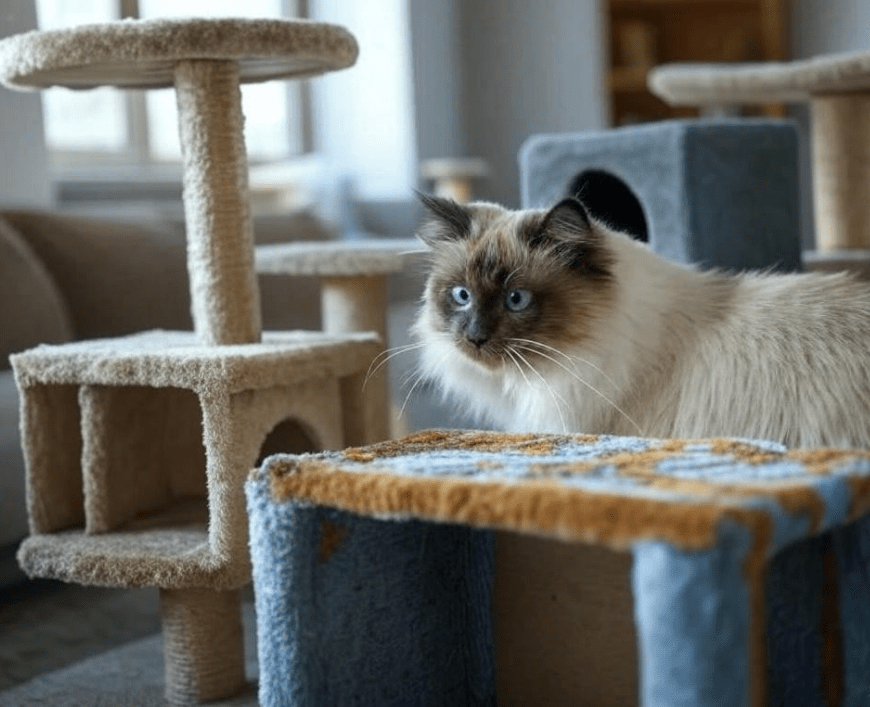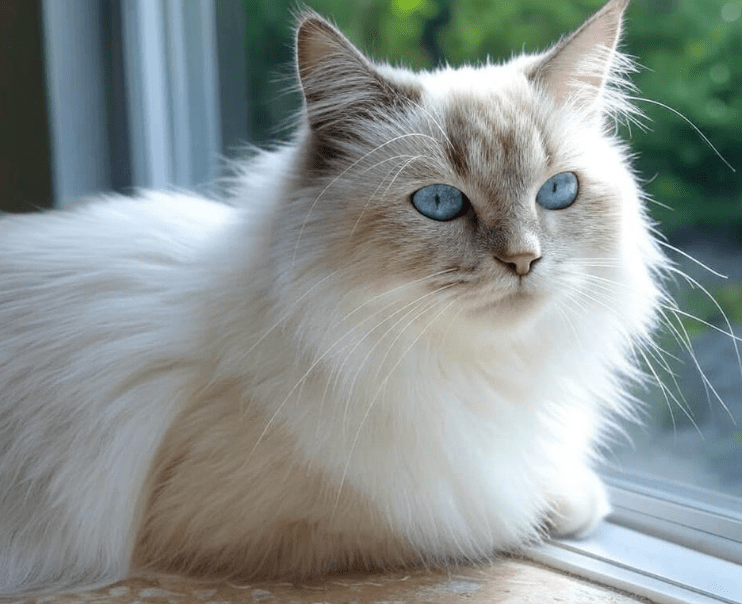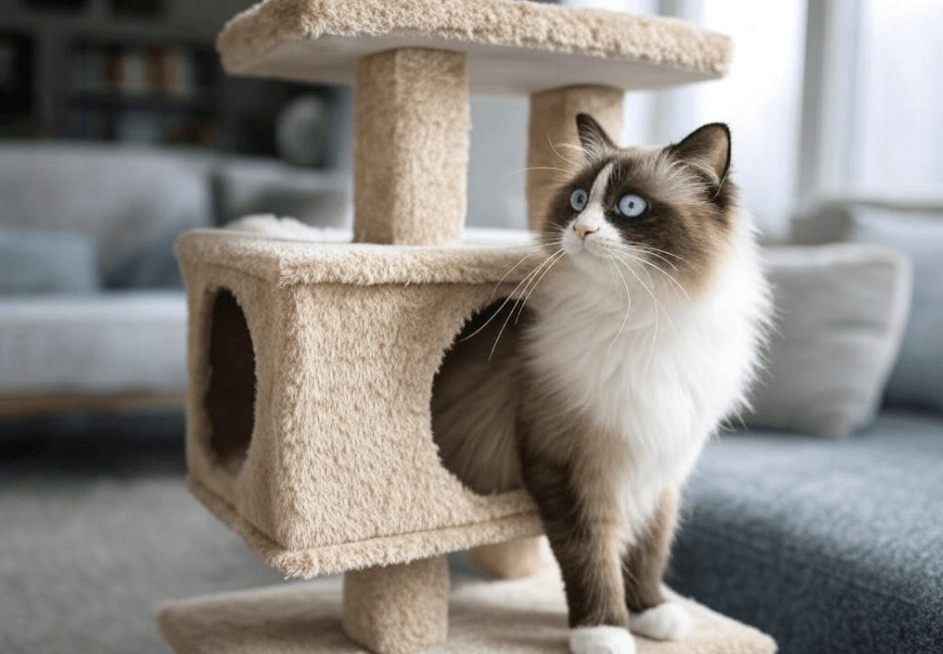
Ragdoll cats, with their gentle demeanor and plush coats, are cherished for their affectionate and calm nature. However, their stoic behavior can make it challenging to recognize pain in Ragdoll cats. Identifying subtle signs of discomfort is crucial for ensuring their health and well-being. This comprehensive guide explores the nuanced indicators of pain in Ragdolls, offering cat owners actionable insights to detect issues early and seek timely veterinary care. By understanding your Ragdoll’s behavior and physical cues, you can provide the care they need to live a comfortable, happy life.
Why Recognizing Pain in Ragdolls Is Important
Ragdolls, like many cats, are adept at hiding pain due to their instincts as both predators and prey. In the wild, showing weakness could make them vulnerable, so they mask discomfort until it becomes severe. For Ragdoll owners, this means subtle signs of pain can easily go unnoticed, delaying diagnosis and treatment. Early detection of pain can prevent minor issues from escalating into serious health problems, improve your cat’s quality of life, and strengthen your bond through attentive care.

Recognizing pain in Ragdoll cats involves understanding their normal behavior and noticing deviations. This article outlines the subtle physical, behavioral, and emotional signs to watch, along with practical steps to respond effectively.
Understanding Ragdoll Behavior and Baseline Health
To recognize pain in Ragdoll cats, you must first establish a baseline for their normal behavior. Ragdolls are typically social, relaxed, and playful, often following their owners around or flopping into a limp, “ragdoll-like” state when picked up. They enjoy routine and are sensitive to changes in their environment. Familiarize yourself with your Ragdoll’s habits, including:
1.Eating and drinking patterns
2.Litter box usage
3.Grooming frequency
4.Activity levels and playfulness
5.Vocalization habits
Sleeping positions and locations
Documenting these behaviors in a journal or app can help you spot changes that may indicate pain. Regular veterinary checkups also provide a professional baseline for your cat’s health.
Subtle Signs of Pain in Ragdoll Cats
Pain in Ragdolls can manifest through physical, behavioral, or emotional changes. Below are the key signs to watch, grouped by category for clarity.
Physical Signs of Pain
Physical symptoms are often the most tangible indicators of pain, though they may be subtle in Ragdolls.
Changes in Posture or Movement:
Hunched Back: A Ragdoll in pain may adopt a hunched posture, especially if experiencing abdominal or spinal discomfort.
Limping or Stiffness: Difficulty walking, reluctance to jump, or favoring one limb may indicate joint pain, arthritis, or injury.
Trembling or Shivering: Unexplained trembling, even in a warm environment, can signal pain or discomfort.
Facial Expressions:
Squinting or Half-Closed Eyes: Cats in pain may partially close their eyes or squint, giving a tense appearance.
Flattened Ears: Ears pressed back or flattened against the head can indicate discomfort.
Grimacing: Look for a tense mouth or slight grimace, which may be subtle but noticeable with close observation.
Changes in Grooming:
Over-Grooming: Excessive licking or chewing on a specific area may indicate localized pain, such as skin irritation or joint discomfort.
Neglecting Grooming: A Ragdoll that stops grooming, resulting in a matted or unkempt coat, may be in pain or too fatigued to maintain their usual routine.
Weight Loss or Appetite Changes:
1.Sudden weight loss or reduced appetite can signal dental pain, gastrointestinal issues, or systemic illness.
2.Conversely, some Ragdolls may overeat due to stress-related pain, leading to weight gain.
Straining or Vocalizing: Difficulty urinating or defecating, or vocalizing during litter box use, may indicate urinary tract issues or constipation.
Avoiding the Litter Box: Pain from arthritis or abdominal issues may make it hard for a Ragdoll to enter or use the litter box, leading to accidents.
Behavioral Signs of Pain
Behavioral changes are often the earliest indicators of pain in Ragdolls, as they reflect discomfort affecting their daily routines.

Reduced Activity:
1.A normally playful Ragdoll may become lethargic, avoiding toys, climbing, or jumping. This could indicate joint pain, muscle injury, or internal discomfort.
2.Reluctance to be picked up or handled, especially in their signature “floppy” state, may suggest pain.
Hiding or Isolation:
1.Ragdolls are social, so hiding under furniture or in secluded areas is a red flag. Pain may drive them to seek solitude to avoid stimulation.
2.Decreased interaction with family members or other pets can also indicate discomfort.
Increased Aggression or Irritability:
1.A typically gentle Ragdoll may hiss, swat, or growl when touched, especially in painful areas. This is a defensive response to protect themselves.
2.Sudden irritability during petting or grooming may point to localized pain.
Altered Sleep Patterns:
1.Sleeping more than usual or in unusual locations (e.g., cooler surfaces for fever relief) can indicate pain or illness.
2.Restlessness or difficulty finding a comfortable position may also be a sign.
Changes in Vocalization:
1.Increased meowing, yowling, or growling, especially during movement or handling, can signal pain.
2.Conversely, a normally vocal Ragdoll becoming silent may be conserving energy due to discomfort.
Emotional Signs of Pain
1.Ragdolls are sensitive, and pain can affect their emotional state, leading to subtle but noticeable changes.
Anxiety or Clinginess:
1.A Ragdoll in pain may become overly clingy, seeking comfort from their owner, or display anxiety through pacing or restlessness.
2.Separation anxiety may worsen if pain disrupts their sense of security.
Loss of Interest:
1.Disinterest in favorite activities, such as chasing a feather wand or lounging in a sunny spot, can indicate emotional distress tied to physical pain.
2.A lack of enthusiasm for treats or affection may also be a clue.
Subtle Stress Signals:
1.Slow blinking, a sign of trust, may decrease if your Ragdoll is in pain.
2.Dilated pupils or a tense expression, even when resting, can reflect stress from discomfort.
Common Causes of Pain in Ragdoll Cats
Understanding potential causes of pain can help you recognize pain in Ragdoll cats and seek appropriate care. Common issues include:

Dental Problems: Gingivitis, tooth resorption, or abscesses can cause facial pain, drooling, or appetite changes.
Arthritis: Older Ragdolls may develop joint pain, leading to stiffness or reluctance to move.
Urinary Tract Issues: Feline lower urinary tract disease (FLUTD) can cause painful urination or litter box avoidance.
Gastrointestinal Issues: Constipation, inflammatory bowel disease, or blockages may result in abdominal pain.
Injuries: Sprains, fractures, or soft tissue injuries from falls or rough play can cause localized pain.
Skin Conditions: Allergies, infections, or parasites can lead to itching and over-grooming.
Chronic Conditions: Kidney disease, hyperthyroidism, or cancer may cause systemic pain in senior Ragdolls.
How to Respond When You Suspect Pain
If you notice signs of pain in your Ragdoll, take prompt action to ensure their comfort and health.
Observe and Document:
1.Note specific symptoms, their frequency, and any triggers (e.g., pain after jumping).
2.Record changes in behavior, appetite, or litter box habits to share with your veterinarian.
Create a Comfortable Environment:
1.Provide soft bedding and easy access to food, water, and the litter box.
2.Minimize stress by maintaining a quiet, stable routine.
Contact Your Veterinarian:
1.Schedule a vet visit as soon as possible, especially for severe symptoms like refusal to eat, vocalizing in pain, or litter box issues.
2.Share your observations to help the vet diagnose the issue. Diagnostic tools like X-rays, blood tests, or ultrasounds may be needed.
Avoid Self-Treatment:
1.Never give your Ragdoll human medications (e.g., ibuprofen, acetaminophen), as they are toxic to cats.
2.Follow your vet’s guidance for pain relief, which may include safe medications or supplements.
Follow Up on Treatment:
1.Administer prescribed treatments, such as antibiotics or pain relievers, as directed.
2.Monitor your Ragdoll’s response and report any changes to your vet.
Preventive Measures to Reduce Pain
While not all pain can be prevented, proactive care can minimize risks and support your Ragdoll’s health.
Regular Veterinary Checkups: Annual or bi-annual exams catch issues early, especially for senior Ragdolls.
Dental Care: Brush your cat’s teeth regularly and schedule professional cleanings to prevent dental pain.
Weight Management: Maintain a healthy weight to reduce stress on joints and prevent obesity-related pain.
Safe Environment: Remove hazards like high perches or sharp objects to prevent injuries.
Stress Reduction: Provide enrichment (toys, scratching posts) and a stable routine to minimize stress-related pain.
High-Quality Diet: Feed a balanced, vet-approved diet to support overall health and reduce the risk of urinary or gastrointestinal issues.
Special Considerations for Ragdoll Kittens vs. Adults
Ragdoll Kittens
Kittens may show pain differently due to their high energy and developing bodies. Watch for:
1.Reluctance to play or explore
2.Excessive vocalization during handling
3.Poor growth or appetite Common issues include injuries from rough play or congenital conditions. Early vet intervention is critical.
Adult and Senior Ragdolls
Adult Ragdolls may develop chronic conditions like arthritis or dental disease. Seniors are particularly prone to kidney issues or cancer. Look for subtle changes in mobility, grooming, or appetite, and schedule more frequent vet visits for aging cats.
When to Seek Immediate Veterinary Care
Some signs of pain require urgent attention. Contact your vet immediately if your Ragdoll shows:
1.Inability to urinate or defecate
2.Severe lethargy or collapse
3.Open wounds or bleeding
4.Difficulty breathing
5.Persistent vomiting or diarrhea
6.Sudden aggression or extreme distress
Working with a Veterinarian
A trusted veterinarian is your partner in recognizing and managing pain in your Ragdoll. Choose a vet experienced with cats, ideally familiar with the Ragdoll breed’s unique needs. During visits:
1.Share detailed observations and ask about pain management options.
2.Discuss preventive care, such as dental cleanings or joint supplements.
3.Consider a referral to a feline specialist for complex issues.
Common Mistakes to Avoid
Ignoring Subtle Signs: Dismissing minor changes can delay diagnosis of serious issues.
Delaying Vet Visits: Waiting too long can worsen pain and complicate treatment.
Misinterpreting Behavior: Aggression or hiding may be mistaken for personality quirks rather than pain.
Using Human Medications: These can be fatal to cats.
Conclusion

Recognizing pain in Ragdoll cats requires vigilance, patience, and a deep understanding of their behavior. By monitoring subtle physical, behavioral, and emotional signs, you can detect discomfort early and seek veterinary care to address underlying issues. With proactive care, a supportive environment, and regular vet checkups, you can ensure your Ragdoll lives a comfortable, pain-free life.
Start observing your Ragdoll closely today and consult your vet if you notice any concerning changes. Have you spotted signs of pain in your Ragdoll or learned tips to manage their health? Share your experiences in the comments to help other Ragdoll owners keep their cats happy and healthy!
